Figures & data
Figure 1. Global occurrence map of Annona crassiflora (araticum). Adapted from: Global Biodiversity Information Facility (GBIF Citation2021).
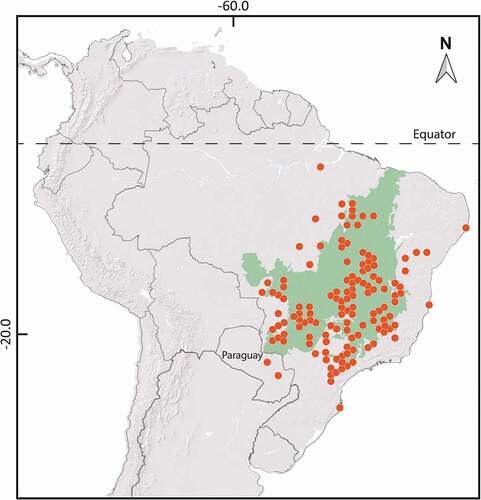
Figure 2. Study area located in the Cerrado of the municipality of Chapada dos Guimarães, MT, with the positions of the 24 individuals of Annona crassiflora analysed in this research (red circles). Source: Google Earth.
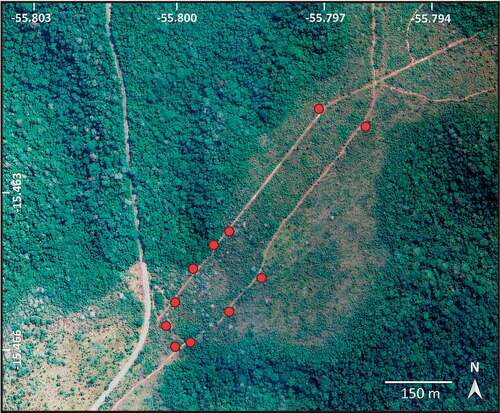
Figure 3. Some steps in the floral cycle of Annona crassiflora in a Cerrado area in the municipality of Chapada dos Guimarães, MT. (a) Developing flower buds photographed in early August, almost two months before the flowering season of A. crassiflora. (b) Open flower chamber photographed in the morning before the onset of anthesis. (c) Flower entering the female phase, photographed from below during crepuscule. Note the sticky, transparent, glossy substance on the gynoecium (the stigmatic exudate; arrow). Petals were spread open to show internal structures.
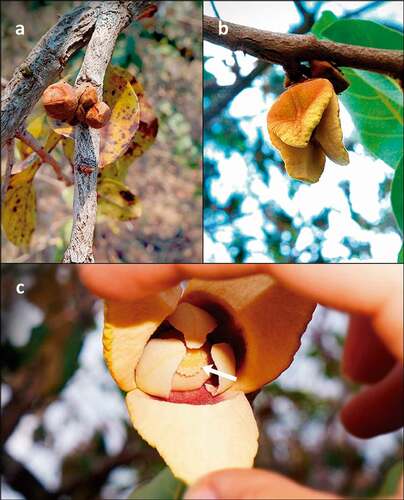
Figure 4. Some steps in the floral cycle of Annona crassiflora in a Cerrado area in the municipality of Chapada dos Guimarães, MT. (a) Interim in the floral cycle. Note that the stigmatic head is detached from the receptacle (arrow). Petals were spread open to show the flower chamber interior. (b) Flower found on the ground in the morning close to anthesis, showing the aspect of the flower during the male phase, with detached stamens filling the floral chamber.
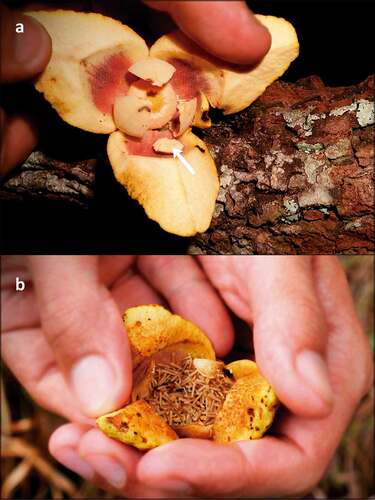
Figure 5. Aspects of floral biology of Annona crassiflora in a Cerrado area in the municipality of Chapada dos Guimarães, MT. (a) Number of sampled flowers (n = 74) according to the floral phase. Note the greater number of male flowers collected in the field relative to the female-phase flowers sampled. (b) Floral thermogenesis during one floral cycle. Note that there are two heat production peaks during the night, one at approximately 7.00pm, when the flowers are in the female phase, and another at approximately 11.00pm, when they are in the male phase. During the interim phase, heat production diminishes without ceasing altogether.
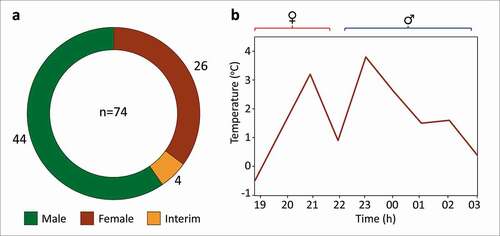
Table 1. List of floral visitors of 74 anthetic Annona crassiflora flowers in a Cerrado area in the municipality of Chapada dos Guimarães, MT. Ni = total number of individuals in each morphospecies found on the flowers. Nf (%) = percentage of flowers in which each listed morphospecies was found. Ni/f = average number of individuals of each morphospecies per flower. PFC (%) = percentage of each morphospecies individual found inside floral chambers. All other specimens were found in the alcohol samples.
Figure 6. Quantitative data on the visitation of Annona crassiflora flowers in a Cerrado area in the municipality of Chapada dos Guimarães, MT. (a) Number of coleopteran and non-coleopteran visitors of anthetic flowers. (b) Number of insect flower visitors sorted by order. (c) Number of beetles visiting anthetic flowers, classified at the family level. (d) Number of beetles visiting anthetic flowers classified at the species and morphospecies levels.

Figure 7. Pollinators of Annona crassiflora in a Cerrado area in the municipality of Chapada dos Guimarães, MT. (a) Dorsal habitus of Cyclocephala octopunctata (male). (b) Dorsal habitus of Cyclocephala octopunctata (female). (c) Dorsal habitus of Cyclocephala celata (male). (d) Dorsal habitus of Cyclocephala celata (female).
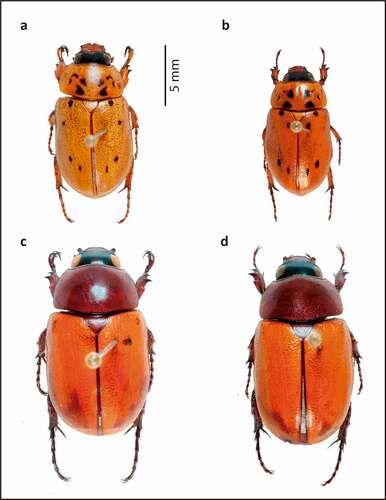
Figure 8. Cyclocephala octopunctata visiting flowers of Annona crassiflora in a Cerrado area in the municipality of Chapada dos Guimarães, MT. (a) A male individual found inside the floral chamber during the female phase. Note the darkening gynoecium, characteristic of an advanced female phase. (b) A specimen covered in pollen found in a male-phase flower. (c) Two individuals inside a female-phase flower. Note that their heads are directed towards the base of the inner petals, where basal alimentary lobes are located. (d) One individual feeding on one basal lobe of an inner petal in a female-phase flower.
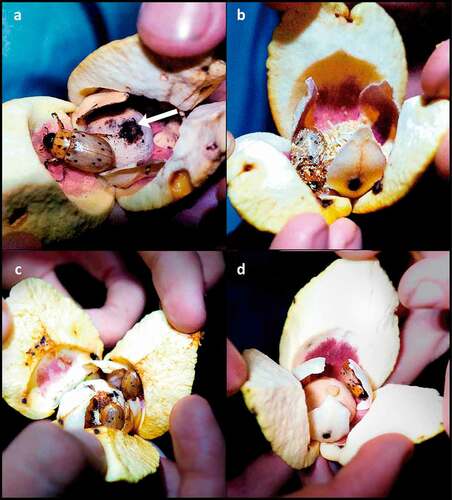
Figure 9. Cyclocephala celata visiting flowers of Annona crassiflora in a Cerrado area in the municipality of Chapada dos Guimarães, MT. (a) Here, the elytra (arrow) of one individual of C. celata are visible inside a female-phase flower. (b) Individuals of C. celata covered in pollen exiting a male-phase flower. (c) Two individuals of C. celata covered in pollen inside a recently fallen corolla that was picked from the ground beneath an A. crassiflora tree. Note that their heads are directed towards the base of the petals, where the nutritious basal lobes are located. (d) This individual of C. celata had just escaped from inside a corolla that was found on the ground under an A. crassiflora individual on the day following flower anthesis.
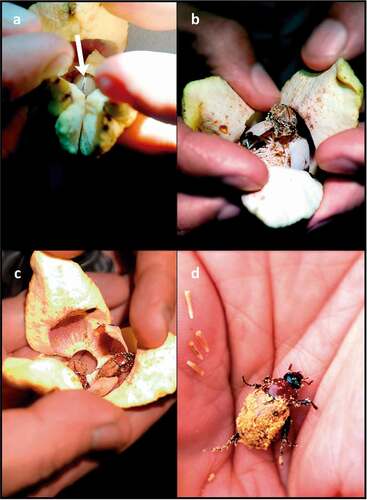
Figure 10. Quantitative data on the visitation of Annona crassiflora flowers by both Cyclocephala species sampled in this study. (a) Number of individuals of Cyclocephala octopunctata (n = 66) classified according to the anthesis phase of the flowers in which they were found. (b) Number of individuals of Cyclocephala celata (n = 16) classified according to the anthesis phase of the flowers in which they were found. (c) Distribution of the number of individuals of C. octopunctata per sampled flower (n = 41 flowers). (d) Distribution of the number of individuals of C. celata per sampled flower (n = 11 flowers).
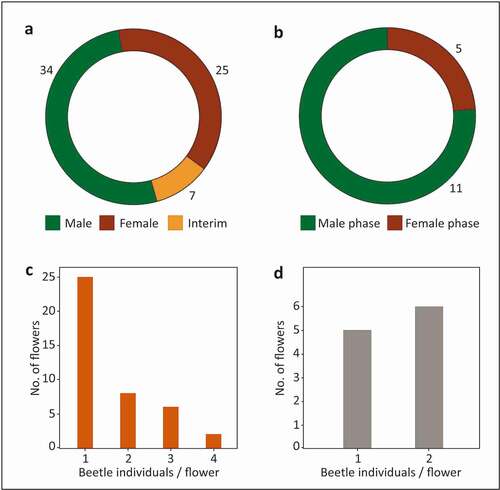
Figure 11. Individuals of Cyclocephalini found in post-anthetic flowers of Annona crassiflora in a Cerrado area in the municipality of Chapada dos Guimarães, MT. (a) A specimen of Cyclocephala celata from a flower found on the ground under the tree crown in the morning after anthesis. Note the pollen tetrads adhered to the tibial and tarsal setae of the right mesothoracic leg. (b) Individuals of C. octopunctata collected in the morning after anthesis from a flower still attached to the pedicel.

